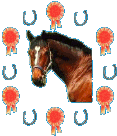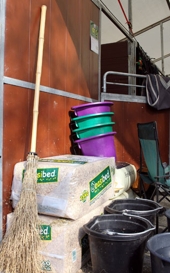HORSE CLUB ONLINE |
BEDDING |
| General Sales | Riding Schools | Horse Services | Lost & Found | Wanted |
|
|
Bedding
|
BEDDING is important for two reasons: It provides a soft cushion for a pony to lie on and makes it easier to keep the stable clean. |
|||||||||||||||||||||||||||||||
Straw |
|||||||||||||||||||||||||||||||||
STRAW is the most common bedding and is widely used and comes in a variety of forms. |
|||||||||||||||||||||||||||||||||
Wheat Straw |
|||||||||||||||||||||||||||||||||
WHEN baled, it is often heavily compacted and brittle, affecting its durability and reducing its value as bedding. Good wheat straw makes excellent bedding but is not easily available. |
|||||||||||||||||||||||||||||||||
Barley Straw |
|||||||||||||||||||||||||||||||||
THIS is usually longer, of better quality and a brighter colour than wheat straw. Barley straw can cause problems if the horse is prone to eat it to excess. |
|||||||||||||||||||||||||||||||||
Oat Straw |
|||||||||||||||||||||||||||||||||
| OAT straw is palatable and more expensive. It quickly becomes saturated, which makes it the least suitable straw for bedding. |
|||||||||||||||||||||||||||||||||
Using Straw |
|||||||||||||||||||||||||||||||||
THE advantages of straw - it gives a clean and bright appearance. Straw manure can be disposed of more easily than other types of materials. In a good harvest year it can be cheap. THE disadvantages of straw is that some horses will eat the straw and it can cause several problems such as allergic coughing to the dust. In a bad harvest, straw can be quite expensive. |
|
|||||

